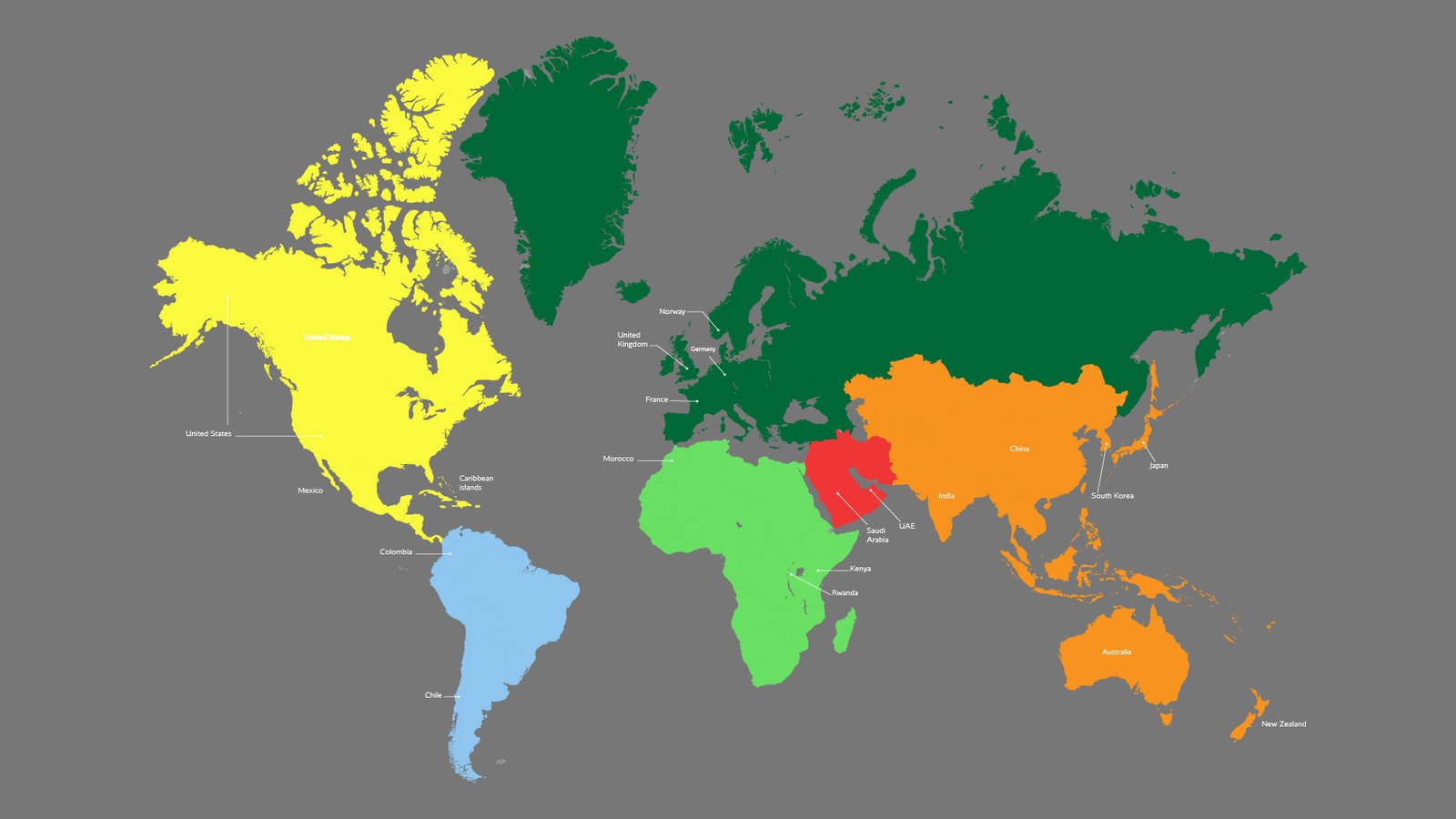Table of Contents
- Introduction
- The Global Plastic Crisis
- Regional Breakdown of Single-Use Plastic Regulations
- Europe
- North America
- Asia-Pacific
- Africa
- Latin America and the Caribbean
- Middle East
- Implementation Challenges
- Success Stories
- Future Trends in Plastic Regulation
- Guide for Businesses
- Conclusion
- References
Introduction
The world is drowning in plastic. Each year, approximately 400 million tons of plastic waste is generated globally, with a significant portion being single-use plastics (SUPs) that are used once and discarded. These items—ranging from grocery bags and food packaging to straws and cutlery—comprise roughly 40% of all plastic produced annually and represent a mounting environmental crisis.
As awareness of plastic pollution has grown, governments worldwide have begun implementing regulations to curb the use of SUPs. However, the regulatory landscape is complex and constantly evolving, with policies varying dramatically from one jurisdiction to another. For businesses operating across borders, sustainability advocates, and concerned citizens, understanding these regulations has become increasingly important.
This comprehensive guide aims to provide a clear visual and written reference to single-use plastic regulations around the world. By mapping these policies, we hope to offer a valuable resource for navigating the changing landscape of plastic regulations and supporting the global transition to more sustainable alternatives.
The Global Plastic Crisis
Before diving into the regulations, it’s essential to understand the scale of the problem. Single-use plastics have become ubiquitous in modern life, offering convenience at the cost of environmental degradation. Consider these statistics:
- An estimated 8 million tons of plastic waste enters our oceans annually
- Plastic bags are used for an average of 12 minutes but take up to 1,000 years to decompose
- By 2050, there could be more plastic than fish in the world’s oceans (by weight)
- Microplastics have been found in the air, water, food, and even human blood
This crisis has prompted action at international, national, and local levels, with varying approaches and degrees of success.
Regional Breakdown of Single-Use Plastic Regulations
Europe
Color Code: Dark Green – Most progressive and comprehensive regulations globally
Europe leads the world in plastic regulation, with the European Union’s Single-Use Plastics Directive serving as a landmark policy. Enacted in 2019, this directive bans several single-use plastic items across all member states, including:
- Plastic cutlery and plates
- Plastic straws and stirrers
- Cotton bud sticks
- Oxo-degradable plastics
- Food containers and beverage cups made of expanded polystyrene
Additionally, the directive includes:
- Extended Producer Responsibility (EPR) schemes
- Consumption reduction targets
- Collection targets for plastic bottles (90% by 2029)
- Minimum recycled content requirements for new plastic bottles
Country Highlights:
France has implemented one of the most ambitious plans, banning all single-use plastic packaging for most fruits and vegetables since January 2022. The country aims to eliminate all single-use plastics by 2040.
Germany has adopted a staged approach, banning various single-use plastic items in July 2021 and implementing a single-use plastic tax in January 2022.
United Kingdom (post-Brexit) has banned plastic straws, stirrers, and cotton buds in England (2020), with Scotland, Wales, and Northern Ireland implementing similar bans. A plastic packaging tax took effect in April 2022, applying to packaging with less than 30% recycled content.
Norway has implemented a successful deposit return scheme for plastic bottles, achieving a recycling rate of approximately 97%.
North America
Color Code: Yellow – Mixed approaches with significant regional variations
North America presents a patchwork of regulations, with stark contrasts between national policies and local initiatives.
United States:
- No comprehensive federal ban on single-use plastics
- Regulatory authority primarily rests with states and municipalities
- Eight states (California, Connecticut, Delaware, Hawaii, Maine, New York, Oregon, and Vermont) have banned single-use plastic bags
- Several cities have banned specific items like plastic straws and polystyrene containers
- California leads with the most comprehensive plastic reduction policies, including the recent passage of laws requiring all plastic packaging to be recyclable or compostable by 2032
Canada:
- Federal ban on six single-use plastic items effective December 2022:
- Checkout bags
- Cutlery
- Foodservice ware made from or containing problematic plastics
- Ring carriers
- Stir sticks
- Straws
- Aims to achieve zero plastic waste by 2030
- Several provinces and municipalities have additional regulations
Mexico:
- No federal ban, but 29 states have enacted legislation restricting plastic bags, and 27 states have regulations on other single-use plastics
- Mexico City has implemented a comprehensive ban on single-use plastics
Asia-Pacific
Color Code: Orange – Varied approaches with rapid policy development
The Asia-Pacific region encompasses some of the world’s largest producers and consumers of plastics, as well as some of the most ambitious policy innovations.
China:
- Banned ultra-thin plastic bags in 2008
- Comprehensive plan to reduce plastic pollution by 2025, including:
- Ban on non-biodegradable bags in major cities by 2022 and all cities by 2025
- Reduction of single-use plastics in the restaurant industry by 30%
- Ban on plastic packaging in courier services in specific regions
India:
- Nationwide ban on single-use plastic items since July 2022, including:
- Plastic sticks for earbuds, balloons, flags, candy sticks, ice-cream sticks
- Plates, cups, glasses, cutlery, straws, packaging films
- Implementation remains challenging due to enforcement capacity
Japan:
- Plastic bag charge introduced in July 2020
- Aims to reduce 25% of single-use plastics by 2030
- Promoting bioplastics as alternatives
Australia:
- All states and territories have banned lightweight plastic shopping bags
- Several states have introduced or announced bans on other single-use plastics
- South Australia leads with the most comprehensive bans
New Zealand:
- Banned plastic shopping bags in July 2019
- Phasing out hard-to-recycle plastics and single-use items by 2025
South Korea:
- Comprehensive plastic reduction strategy, including:
- Ban on plastic bags in supermarkets
- Prohibition of disposable products in coffee shops for dine-in customers
- Target to reduce plastic waste by 50% and increase recycling to 70% by 2030
Africa
Color Code: Light Green – Early adoption with implementation challenges
Africa has shown surprising leadership in plastic regulation, with many countries implementing bans before their wealthier counterparts.
Rwanda:
- Pioneered plastic bag bans in 2008
- Strict enforcement, including searches at borders
- One of the cleanest countries in Africa as a result
Kenya:
- Implemented one of the world’s strictest plastic bag bans in 2017
- Penalties include up to four years in prison or fines up to $40,000
- Visible reduction in plastic litter
Morocco:
- Banned plastic bags in 2016
- Developing local alternatives, including traditional woven bags
Tanzania, Uganda, and South Africa have also implemented various plastic bans, though enforcement remains a challenge in many regions.
Latin America and the Caribbean
Color Code: Light Blue – Growing momentum with coastal protection focus
Many Latin American and Caribbean nations have implemented plastic regulations, often focused on protecting coastal ecosystems critical to tourism.
Chile:
- First South American country to ban retail plastic bags nationwide (2019)
- Expanding regulations to other single-use items
Colombia:
- Banned plastic bags smaller than 30×30 cm and introduced a tax on larger bags
- Multiple cities have additional regulations
The Caribbean:
- Many island nations have banned various single-use plastics due to tourism impacts
- Antigua and Barbuda, Barbados, Belize, The Bahamas, Dominica, Grenada, Jamaica, St. Lucia, and Trinidad and Tobago all have bans on specific items
Middle East
Color Code: Red – Emerging regulations with implementation gaps
United Arab Emirates:
- Dubai introduced a 25 fils charge for single-use bags in 2022, with plans for a complete ban
- Abu Dhabi banned single-use plastic bags in June 2022
Saudi Arabia:
- Launched initiatives to reduce plastic consumption
- No comprehensive ban yet
Israel:
- Plastic bag charge introduced in 2017
- Limited regulations on other single-use items
Implementation Challenges
Despite the proliferation of regulations, several challenges persist:
Enforcement capacity: Many jurisdictions, particularly in developing nations, lack the resources to enforce plastic bans effectively.
Industry resistance: Plastic manufacturers and related industries often lobby against regulations or seek loopholes.
Alternative availability: Sustainable alternatives are not always readily available or affordable, especially in lower-income regions.
Consumer behavior: Changing entrenched consumer habits requires time, education, and accessible alternatives.
Exemptions: Many regulations include exemptions for medical use, accessibility needs, or certain industries, creating confusion and potential loopholes.
Success Stories
Despite these challenges, some notable success stories have emerged:
Rwanda’s Clean Environment: Through strict enforcement of its plastic bag ban and monthly community cleanup days, Rwanda has become one of Africa’s cleanest nations.
Ireland’s Plastic Bag Tax: Introduced in 2002, it reduced plastic bag usage by over 90% within a year.
San Francisco’s Comprehensive Approach: The city’s incremental approach to banning various single-use plastics has led to a 80% waste diversion rate.
South Korea’s Deposit Refund Scheme: The country’s innovative approach to beverage containers has dramatically increased recycling rates.
Future Trends in Plastic Regulation
Several trends are shaping the future of plastic regulations:
Lifecycle approach: Regulations are increasingly addressing the entire lifecycle of plastics, from production to disposal.
Extended Producer Responsibility (EPR): More jurisdictions are making producers responsible for the end-of-life management of their products.
Microplastic regulation: Growing recognition of microplastic pollution is driving new regulations targeting microbeads, synthetic fibers, and tire dust.
International coordination: Efforts like the proposed UN Global Plastics Treaty aim to create more consistent international standards.
Circular economy focus: Regulations are increasingly designed to support circular economy principles rather than simple bans.
Guide for Businesses
For businesses navigating this complex regulatory landscape, consider the following approach:
1. Conduct a plastic footprint assessment:
- Inventory all single-use plastics in your operations and supply chain
- Identify high-volume and high-risk items
- Quantify environmental impact
2. Monitor regulatory developments:
- Subscribe to regulatory updates for relevant jurisdictions
- Participate in industry associations that track plastic regulations
- Engage with policymakers when possible
3. Develop a plastic reduction strategy:
- Set clear targets and timelines
- Prioritize actions based on regulatory requirements and environmental impact
- Consider the full lifecycle of alternative materials
4. Innovate and collaborate:
- Invest in sustainable packaging research and development
- Partner with suppliers, customers, and even competitors on circular solutions
- Support extended producer responsibility systems
5. Communicate transparently:
- Report progress and challenges honestly
- Educate consumers about your efforts and how they can participate
- Avoid greenwashing by ensuring claims are substantiated
Conclusion
The global regulatory landscape for single-use plastics is complex and rapidly evolving. While the patchwork of regulations presents challenges for multinational businesses and consumers alike, it also reflects growing global recognition of the plastic pollution crisis and commitment to addressing it.
By understanding the current state of regulations and anticipating future trends, businesses and individuals can better prepare for the transition away from single-use plastics. Whether motivated by compliance requirements, consumer demand, or environmental concerns, reducing plastic waste is increasingly becoming a necessity rather than a choice.
As we navigate this changing landscape, the goal remains clear: to break free from our dependence on disposable plastics and build a more sustainable relationship with the materials we use. The regulations mapped in this guide represent important steps toward that goal—imperfect and incomplete, but nevertheless significant in the global effort to address one of our most pressing environmental challenges.
References
- Ellen MacArthur Foundation. (2016). The new plastics economy: Rethinking the future of plastics. https://ellenmacarthurfoundation.org/the-new-plastics-economy
- Environment and Climate Change Canada. (2022). Single-use plastics prohibition regulations. https://www.canada.ca/en/environment-climate-change/services/managing-reducing-waste/reduce-plastic-waste/single-use-plastics.html
- European Parliament and Council. (2019). Directive (EU) 2019/904 on the reduction of the impact of certain plastic products on the environment. https://eur-lex.europa.eu/legal-content/EN/TXT/?uri=CELEX%3A32019L0904
- Jambeck, J. R., Geyer, R., Wilcox, C., Siegler, T. R., Perryman, M., Andrady, A., Narayan, R., & Law, K. L. (2015). Plastic waste inputs from land into the ocean. Science, 347(6223), 768–771. https://doi.org/10.1126/science.1260352
- Leslie, H. A., van Velzen, M. J. M., Brandsma, S. H., Vethaak, A. D., Garcia-Vallejo, J. J., & Lamoree, M. H. (2022). Discovery and quantification of plastic particle pollution in human blood. Environment International, 163, 107199. https://doi.org/10.1016/j.envint.2022.107199
- Ministry of Ecology and Environment of China. (2020). Work plan for plastic pollution control. [In Chinese] http://www.mee.gov.cn/
- Ministry of Environment, Republic of Korea. (2019). Plastic waste management strategies. http://eng.me.go.kr/
- Ministry of Environment, Forest and Climate Change, India. (2022). Plastic Waste Management Rules, 2022. https://moef.gov.in/
- National Conference of State Legislatures. (2023). State plastic bag legislation. https://www.ncsl.org/environment-and-natural-resources/state-plastic-bag-legislation
- National Geographic. (2018). Planet or plastic?. https://www.nationalgeographic.com/environment/article/plastic-pollution
- Rwanda Environment Management Authority. (2008). Plastic bag ban implementation report. https://rema.gov.rw/
- Saudi Green Initiative. (2022). Plastic consumption reduction efforts. https://www.saudigreeninitiative.org/
- UK Government – Department for Environment, Food & Rural Affairs. (2020–2022). Plastic packaging tax and bans. https://www.gov.uk/guidance/plastic-packaging-tax
- United Nations Environment Programme. (2018). Single-use plastics: A roadmap for sustainability. https://www.unep.org/resources/report/single-use-plastics-roadmap-sustainability
- Infinitum. (2021). Norway’s deposit return system report. https://infinitum.no/
- Israel Ministry of Environmental Protection. (2017). Plastic bag reduction levy. https://www.gov.il/en/departments/ministry_of_environmental_protection
- San Francisco Department of the Environment. (2020). Waste diversion rate statistics. https://sfenvironment.org/
- French Ministry for the Ecological Transition. (2021). Anti-waste law for a circular economy. https://www.ecologie.gouv.fr/
- Caribbean Community Secretariat. (2020). Regional Action Plan for Marine Litter Management. https://caricom.org/
- Ministry of Environment, Japan. (2019). Plastic resource circulation strategy. https://www.env.go.jp/
- New Zealand Ministry for the Environment. (2021). Phase-out of hard-to-recycle plastics and single-use items. https://environment.govt.nz/
- Australian Government Department of Climate Change, Energy, the Environment and Water. (2023). National Plastics Plan. https://www.dcceew.gov.au/
- Irish Department of Communications, Climate Action and Environment. (2002). Plastic bag levy results. https://www.gov.ie/
- Ministry of Environment and Sustainable Development, Colombia. (2017). Plastic bag regulation. https://www.minambiente.gov.co/
- Environment Agency – Abu Dhabi. (2022). Single-use plastics policy. https://www.ead.gov.ae/
For the most current information on specific regulations in your region, we recommend consulting local environmental agencies or legal counsel specializing in environmental compliance.
This article was produced by UKHI as part of our commitment to advancing sustainable practices through education and awareness. For more information on sustainable solutions and environmental regulations, visit our website or contact our sustainability team.
Add Your Heading Text Here

Vishal Vivek
Vishal Vivek, CEO & Co-Founder of UKHI, is a sustainability entrepreneur and the former founder of Hemp Foundation, where he empowered 1,000+ farmers through 100+ SHG workshops. An MIT Bootcamp and Stanford Spark-Seed alumnus, his work—honored with the HDFC Parivartan Award—combines sustainable agriculture, innovation, and business strategy to drive both economic empowerment and environmental change.


